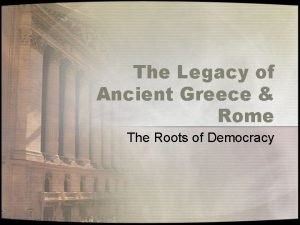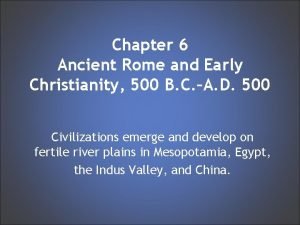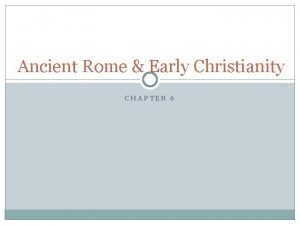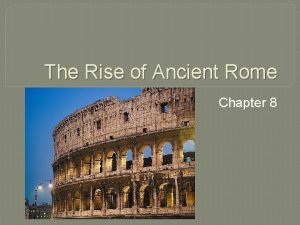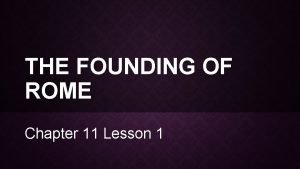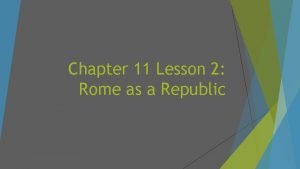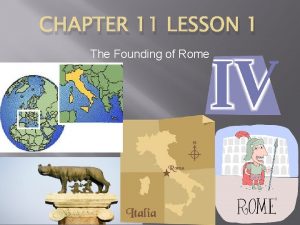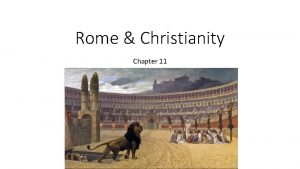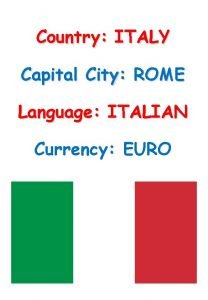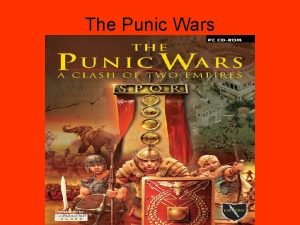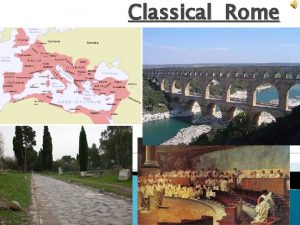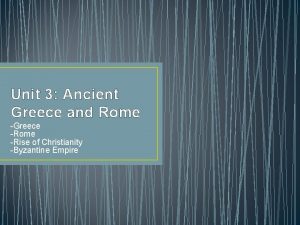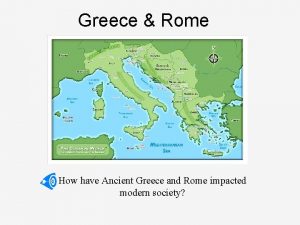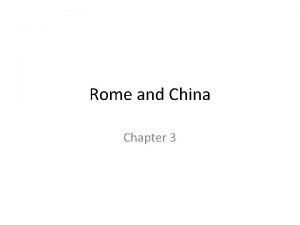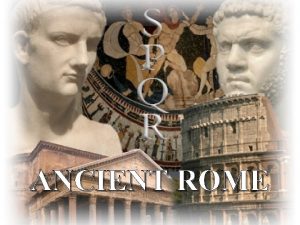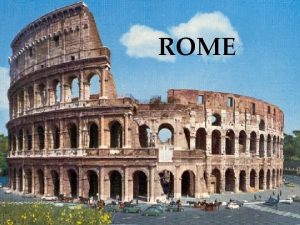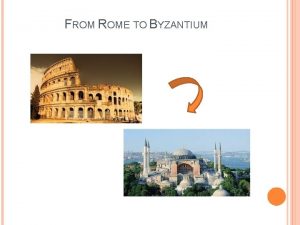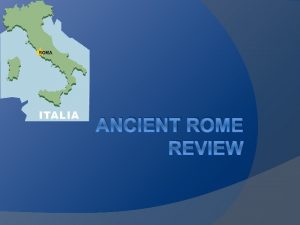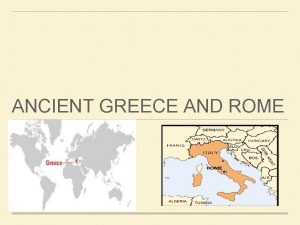UNIT 1 GREECE AND ROME Chapter 5 Greece
















- Slides: 16

UNIT 1 – GREECE AND ROME Chapter 5 – Greece Chapter 6 – Rome

SECTION 1 Ancient Rome, 500 B. C. – A. D. 500 CHAPTER 6 Republic The Roman SECTION 2 The Roman Empire SECTION 4 The Fall of the Roman Empire SECTION 5 Rome and the Roots of Western Civilization

OBJECTIVES � CORE OBJECTIVE: Analyze the impact of Ancient Rome and how it continues to impact our lives today. �Objective 1. 5: Explain the main institutions of the Roman Republic. � THEME: The Roman culture will have a significant impact and influence on many other world cultures.

CHAPTER 6 SECTION 1 THE ROMAN REPUBLIC The early Romans establish a republic, which grows powerful and spreads its influence.

ROMAN LOCATION & GEOGRAPHY � Rome was the capital of the ancient Roman Empire and present day Italy � � � Built on seven hills on Tiber River � � Site of Rome chosen for its fertile soil and strategic location Located on Italian peninsula in center of Mediterranean Sea Rome was only a small town on the Tiber River when Athens was at the height of its glory. The myth is that twins sons Romulus and Remus of the god Mars founded the city around 753 B. C. � The gods, arts, and architecture resembles the Greeks

THE ORIGINS OF ROME � Latins, Greeks, and Etruscans compete for control of region � Latins found original settlement of Rome between 1000 and 500 B. C. � Etruscans native to northern Italy; influence Roman civilization

THE EARLY REPUBLIC � Early WRITE THIS DOWN! Rulers � Around 600 B. C. , Etruscan kings begin to rule Rome � Romans overthrow cruel Etruscan king Tarquin in 509 B. C. � Romans found a republic — government in which citizens elect leaders

CITIZENS OF ROME � Different groups struggle for power in early Roman Republic � Patricians — wealthy landowning class that holds most of the power • Were elected to the Senate � Plebeians — common citizens, can vote, can’t rule • artisans, merchants, and farmers � Tribunes — elected representatives protect plebeians’ political rights WRITE THIS DOWN!

ROMAN LAW � In 451 B. C. officials carve Roman laws on twelve tablets � Twelve Tables - become basis for Roman law � � � Tables give protection of law to all free citizens Citizenship is limited to adult male landowners Twelve Tables are hung in the Forum WRITE THIS DOWN!

EVOLUTION OF THE ROMAN FORUM � http: //www. history. com/topics/ancienthistory/ancient-rome/videos/evolution-of-the-romanforum

MILITARY � The Roman Army � � Roman legion — military unit of 5, 000 infantry; supported by cavalry Army is powerful; key factor in Rome’s rise to greatness All citizens who owned were required to serve in the army Rome Conquers Italy � � WRITE THIS DOWN! Romans defeat Etruscans in north and Greek city-states in south By 265 B. C. , Rome controls Italian peninsula Conquered peoples treated justly; this enables Rome to grow Rome’s Commercial Network � � � Rome establishes large trading network Access to Mediterranean Sea provides many trade routes Carthage, powerful city-state in North Africa, soon rivals Rome

CARTHAGE AND THE PUNIC WARS

PUNIC WARS � Rome and Carthage begin Punic Wars — three wars between 264– 146 B. C. � � Rome defeats Carthage, wins Sicily, in first 23 -year war Hannibal — Carthaginian general — avenges defeat in Second Punic War Attacks Italy through Spain and France, doesn’t take Roman general Scipio defeats Hannibal in 202 B. C. � � WRITE THIS DOWN! Hannibal later poisoned himself rather than become a prisoner of the Romans. Rome destroys Carthage, enslaves people in last war

PUNIC WARS MAP

THE ROMAN REPUBLIC — ASSESSMENT � Which of the following is NOT true about the Roman code of laws known as the Twelve Tables? a. b. c. d. � It gave legal protection to all citizens It officially removed senators from power It was written down It was publicly displayed After the Romans drove the last Etruscan monarch from power, they established a republic, a government in which a. b. c. d. Power rests with a small minority who are supported by the military Power rests with the citizens who participate directly in law-making Power rests with citizens who select their leaders Power rests with the nobility and the wealthy

THE ROMAN REPUBLIC — ASSESSMENT � Which of the following is NOT true about the Roman code of laws known as the Twelve Tables? a. b. c. d. � It gave legal protection to all citizens It officially removed senators from power It was written down It was publicly displayed After the Romans drove the last Etruscan monarch from power, they established a republic, a government in which a. b. c. d. Power rests with a small minority who are supported by the military Power rests with the citizens who participate directly in law-making Power rests with citizens who select their leaders Power rests with the nobility and the wealthy
 Myths of greece and rome
Myths of greece and rome The glory that was greece and the grandeur that was rome
The glory that was greece and the grandeur that was rome Greek physical education
Greek physical education The legacy of ancient greece and rome
The legacy of ancient greece and rome Babylon medo-persia, greece rome timeline
Babylon medo-persia, greece rome timeline Ancient rome and early christianity
Ancient rome and early christianity Ancient rome and early christianity chapter 6
Ancient rome and early christianity chapter 6 Unit 10, unit 10 review tests, unit 10 general test
Unit 10, unit 10 review tests, unit 10 general test Roman empire in first century
Roman empire in first century Chapter 11 lesson 1
Chapter 11 lesson 1 Guided reading lesson 2 rome as a republic answer key
Guided reading lesson 2 rome as a republic answer key Chapter 11 lesson 1 the founding of rome
Chapter 11 lesson 1 the founding of rome Chapter 11 rome republic to empire
Chapter 11 rome republic to empire Rome 2 chapter objectives
Rome 2 chapter objectives Ancient greece unit test
Ancient greece unit test Currency and capital of italy
Currency and capital of italy The punic wars were fought between rome and
The punic wars were fought between rome and



